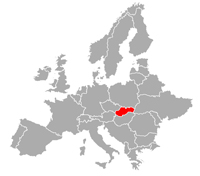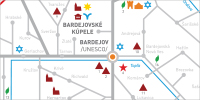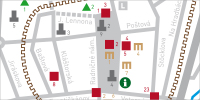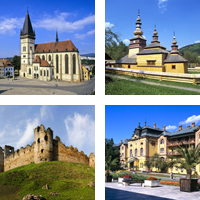|
                   
|
First signs of human activity in the vicinity of Bardejov are dated to the Paleolithic. The nebulous past is illuminated by period artefacts. Two precious flint blades are now stored in the Šariš Museum. Both pieces are an example of the Gravettian tool-making culture dated to Upper Paleolithic (around 20 000 BCE). Isolated hunter groups most probably migrated through the area. The Eneolithic period (2500 – 1800 BCE) is arguably the most interesting part of local history. The period witnessed the erection of Stone tumuli – some of which are preserved till today.
The strategic position of the town, located along a major trade route, encouraged settlement during the middle ages. The route led from the south of Prešov via river valleys of Sekčov and Šibská voda, crossing north beyond the Carpathians at the least via three passages.
The oldest written source about Bardejov comes from the Russian Primary Chronicle related to date 1241. Bardejov was located on an important trade route connecting Medieval Hungary, Poland and Galicia. The charter of king Béla IV issued in 1247 mentions the town as an already developed settlement. The subject of document is a plea of the Cistercians to the king. The monks requested renewed marking of their land boundaries since the Germans of Prešov damaged the old ones.
In the middle of the thirteenth century Bardejov acquired the right to maintain a market place. The market place brought new tradesmen as well as German colonists. The king Charles Robert gave the newcomers major privileges in 1320. King Louis I stipulated in 1352 that the town has to defend itself by a wall and bastions. The decree showed the strategic value of Bardejov with its position on the borderlands between the kingdom of Poland and Hungary. In addition the town also received the right to hold a fair on Saint Egidius day from the King. The right to execute suspected criminals (Ius Gladii) was given to the town in 1365. The town’s authorities were then able to perform hangings, decapitations and torture of criminals. For minor offences the suspects were jailed and beaten by a stick. The most prestigious achievement for the town was, however, the king’s decree of 1376 that elevated Bardejov to the status of a free royal town.
|
The town’s golden age came in the fifteenth century. The era saw a major development of local trade and crafts. The town was home to more than 50 guilds and more than 64 types of artisans. Foreign tradesmen were obliged to sell their goods in the town after the town was given the right of stock in 1402. In 1427 King Sigismund of Luxembourg prolonged the length of the fair from eight to fourteen days and permitted an additional fair. The biggest income came from the production of linen. The town’s wealth increased in the period substantially and included several vineyards of famous the Tokaj area.
The wine, a major item of export, was sold to southern Polish cities – especially Cracow. A sawmill, a mill, a brickyard, a brewery, a salt deposit and a glass factory raised the town’s importance further. A Polish army occupied the city in the period 1402 – 1403. In 1412 king Sigismund of Luxembourg pawned Bardejov to the Polish nobleman Balicki. King Ladislaus V Posthumous granted the city its own coat of arms in 1453.
The sixteenth century saw the development of art, culture and science. The main impetuous brought by the reformation left notable influence on politics and culture. Bardejov was the home to one of the major figures of reformation – Leonard Stöckel. The scholar drafted the document Confessio Pentapolitana in 1549 which openly professed the protestant faith of the cities of Košice, Prešov, Bardejov, Sabinov and Levoča. A local gymnasium – the center of town’s science of culture and the first public library in the kingdom of Hungary – significantly improved education. The publishing houses of Dávid Gutgesel and Jakub Klosz added additional fame to Bardejov.
During the war riddled seventeenth century Bardejov suffered from constant raids of imperial and insurgent forces. Outbreaks of bubonic plague took its tool as well. Great fires of 1679 and 1686 destroyed almost all of the settled area. A long period of restoration was interrupted by plague in 1710 – 1711 which left 2000 dead.
|
The nearby Spa of Bardejov helped the town to gain more popularity, especially during the eighteenth and nineteenth century. A historical milestone came with the introduction of a railway in 1893. The fires of 1878 and 1902 were the most destructive in city’s history and caused emigration and poverty. Despite this, at the turn of the twentieth century, minor industry developed and a local toy factory even became internationally famous. In 1894 the hotel Republika was built, followed by a hospital a year later and a theatre hall in 1897.
World War I also impacted the surrounding area of the city. From the fall of 1914 until spring 1915 the area witnessed heavy fighting between the Russian and Austro-Hungarian army. The post-War period, on the other hand, saw growth and development of democratic structures in the newly created Czechoslovakia. In addition Bardejov also became a safe haven for Polish refugees who longed for a life in a tolerant and prosperous environment. The steady positive progress was however stopped by the world economic crisis.
The Second World War brought many casualties and changed the character of the city forever. Period regime allied with the Nazis persecuted the local Jewish community and contributed to its extermination.
The town saw progress in post-war period again. The number of workplaces increased and consequentially villagers moved in great numbers to Bardejov. The Saint Egidius church and the historical town hall were also restored during this period. The international committee UNESCO/ICOMOS gave the town a European Gold Medal for its efforts in heritage preservation.
The historical core of the town as well as the Jewish Suburbia complex was officially registered into UNESCO World Heritage in 2000. This signaled an era of a new millennium for Bardejov.
Translated by:
Mgr. Samuel Beňa, M.A.
|






















